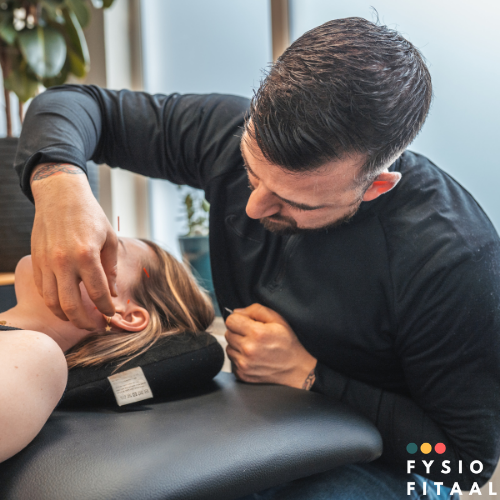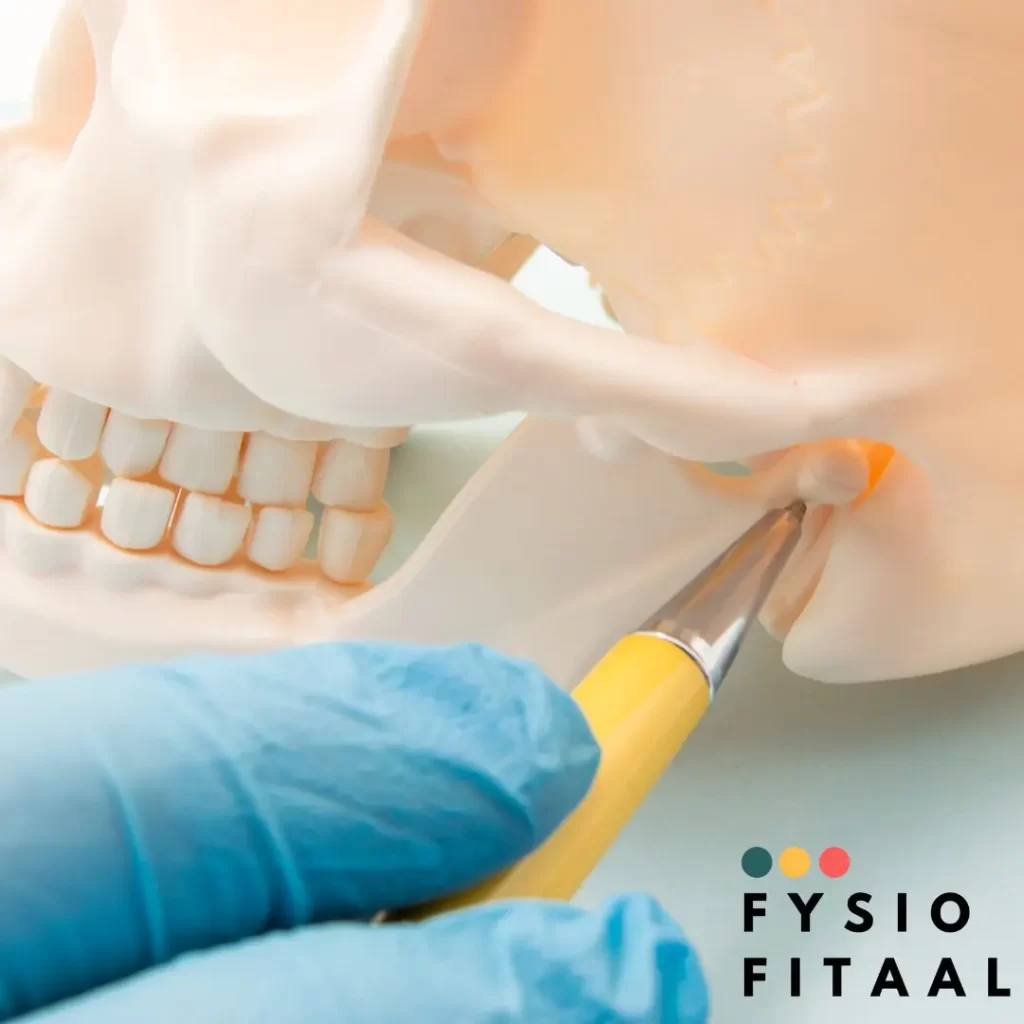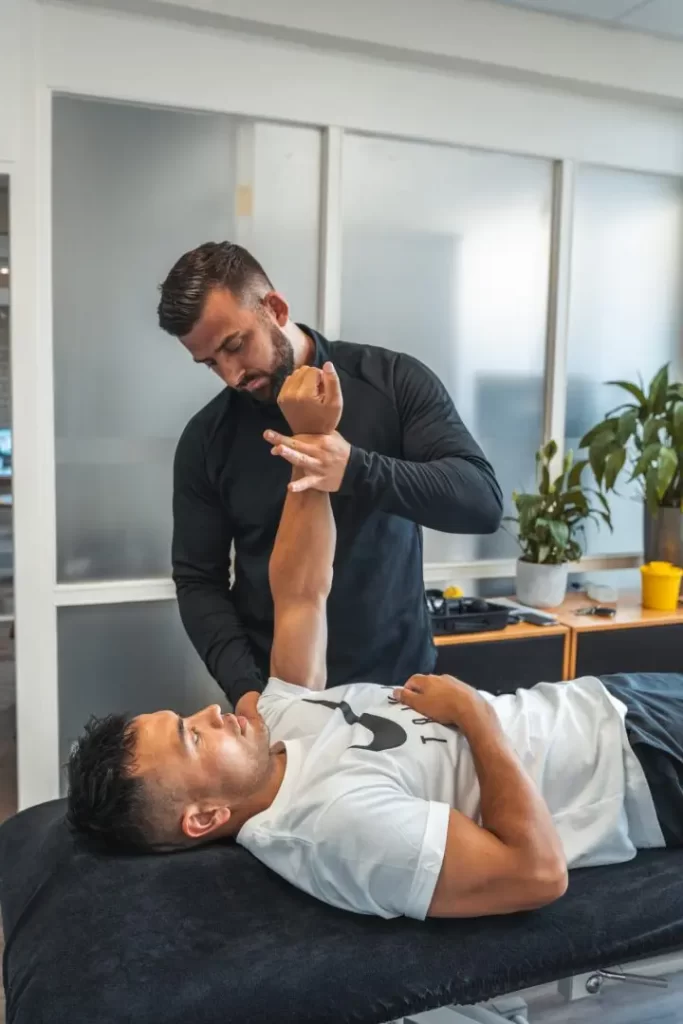Jaw complaints
10% of the adult population experiences complaints of the jaw joint at some point. Temporomandibular dysfunction(TMD) is an umbrella term for complaints in the jaw region. TMDs are complaints of the jaw that manifest as pain, decreased jaw mobility and possibly a creaking sound of the jaw when talking, eating or swallowing.

Cause
Jaw pain can have various causes, such as overuse due to teeth grinding or clenching (bruxism), stress, jaw trauma or joint problems such as a dysfunctional jaw joint (TMD). Dental problems, such as an abnormal bite or dental procedures, can also contribute to jaw pain. In addition, jaw pain can sometimes originate from the neck region. Muscle tension and movement restrictions in the neck can lead to increased tension in the masseter muscles and jaw joint, which can cause pain and restrictions. This often occurs with incorrect posture or prolonged neck strain due to stress or work posture. Symptoms range from pain and stiffness to difficulty chewing and opening the mouth. A physiotherapist or dentist can help with proper diagnosis and treatment.
Common Jaw complaints
Risk factors
- Age between 35-44
- More common in women than men
- Smokers have increased risk of jaw problems
- Psychological complaints such as depression
- Jaw clenching or teeth grinding
- Over- or underbite
- Jaw surgery in the past

Grades
Grades
Jaw pain can be classified into different degrees based on severity and impact on daily functioning:
Grade 1: Mild symptoms
- Slight muscle tension or stiffness in the jaw without obvious restriction of movement.
- Complaints occur mainly with prolonged talking, chewing or stress, but disappear with rest.
- Treatment: simple relaxation exercises, hot/cold therapy and awareness of jaw habits.
Grade 2: Moderate complaints
- Obvious pain and stiffness, sometimes radiating to head, neck or ears.
- Restrictions on chewing or opening the mouth.
- Possible side noises in the jaw joint, such as clicking or creaking.
- Treatment: physiotherapy, jaw relaxation techniques, dry needling or adapted nutrition (soft food temporarily).
Grade 3: Severe complaints
- Persistent or severe pain, both at rest and with movement of the jaw.
- Severe limitation in mouth opening (e.g. unable to yawn, eat or talk properly).
- Possible locking or jamming of the jaw joint.
- Treatment: specialised physiotherapy, dental interventions, in some cases medical interventions or splinting by the dentist.
The severity of the symptoms determines what treatment is needed and how long the recovery process takes
Complaints of the jaw joint
TMD is characterised by regional acute- or persistent pain at the ear or in the lower jaw or by reduced function of the jaw during, for example, eating or yawning. Headache can also arise from these symptoms often radiating from the jaw to the side of the face/head. Because it is an umbrella term, you can still distinguish between different types of TMD.
Muscle-related TMD - here the cause is located in the jaw muscles
- Local pain in the jaw on the affected muscle
- Myofascial pain on palpation spreading throughout the muscle
- Myofascial pain with radiation, this is pain that radiates beyond the muscle alone
Arthrogenic TMD here the cause is found in the joint.
- Arthrogenic: Pain on jaw movements (even unloaded)
- TMJ disc disorder where the disc does not move properly or when there is disc degeneration where the disc is affected.
All images show complaints in or around the jaw joint though in a myogenic image the radiating areas may differ.
Anatomy of the jaw joint
The joint of the jaw lies just in front of the ear, at this place the bone of the lower jaw meets the bone of the skull. Between these two pieces of bone lies a small cartilage disc. When the jaw moves, it slides with it to make the movement as smooth as possible.
Looking at the muscles, the jaw has 4 major muscles that perform two main movements, opening and closing the jaw. The two largest muscles are the m. Temporalis and the M. Masseter both allow the jaw to close in a forceful manner. Of the two smaller muscles m. Pterygoideus medialis and lateralis, the pterygoideus medialis is also for closing the jaw. The m. pterygoideus lateralis is responsible for opening the jaw.
Treatment of TMD
Treatment depends on what kind of jaw complaints the person has. However, there is a basis with which most complaints can be treated. It may be that the therapist puts more focus on a specific part compared to the rest
The following techniques are often used:
- Manual jaw region (mobilisation)
- Manual Neck region (mobilisation)
- Massage therapy
- Stretch
- Exercises for the jaw and neck muscles
Physical testing of the jaw joint
Axis I temporomandibular diagnosis; in the first part of the examination, the jaw itself is inspected, the mobility of the jaw is looked at how the function is at that moment. The therapist looks to see if he can possibly provoke the symptoms with further physical examination. Axis 2 we look at the severity of the complaints(psychosocial). This is designed to investigate how a client copes with the complaints. Based on this, we draw up a treatment plan together.
Making an appointment at FysioFitaal
We work from multiple locations in Tilburg, always close by for professional and accessible physiotherapy. Fill in the contact form and we will contact you soon. Together, we will work on your recovery!

